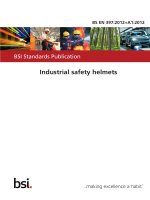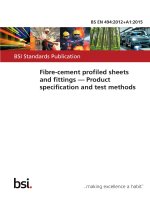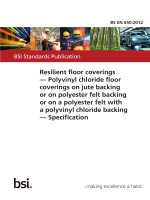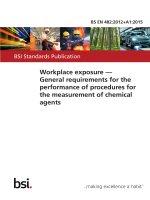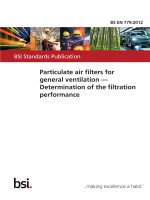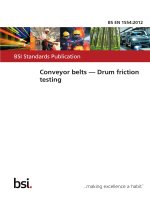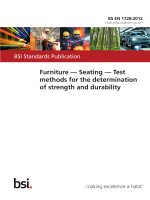Bsi bs en 62423 2012
Bạn đang xem bản rút gọn của tài liệu. Xem và tải ngay bản đầy đủ của tài liệu tại đây (2.07 MB, 48 trang )
BS EN 62423:2012
Incorporating corrigendum December 2011
BSI Standards Publication
Type F and type B
residual current operated
circuit-breakers with and
without integral overcurrent
protection for household
and similar uses
BRITISH STANDARD
BS EN 62423:2012
National foreword
This British Standard is the UK implementation of EN 62423:2012. It is
derived from IEC 62423:2009, incorporating corrigendum December 2011.
The start and finish of text introduced or altered by corrigendum is
indicated in the text by tags. Text altered by IEC corrigendum December
2011 is indicated in the text by ˆ‰.
The CENELEC common modifications have been implemented at the
appropriate places in the text. The start and finish of each common
modification is indicated in the text by tags }~.
The UK participation in its preparation was entrusted by Technical
Committee PEL/23, Electrical accessories, to Subcommittee PEL/23/1,
Circuit breakers and similar equipment for household use.
A list of organizations represented on this committee can be obtained on
request to its secretary.
This publication does not purport to include all the necessary provisions of
a contract. Users are responsible for its correct application.
© The British Standards Institution 2013. Published by BSI Standards
Limited 2013
ISBN 978 0 580 69889 7
ICS 29.120; 29.120.50
Compliance with a British Standard cannot confer immunity from
legal obligations.
This British Standard was published under the authority of the Standards
Policy and Strategy Committee on 30 April 2013.
Amendments/corrigenda issued since publication
Date
Text affected
EN 62423
EUROPEAN STANDARD
NORME EUROPÉENNE
EUROPÄISCHE NORM
December 2012
ICS 29.120; 29.120.50
Supersedes EN 62423:2009
English version
Type F and type B residual current operated circuit-breakers with and
without integral overcurrent protection for household and similar uses
(IEC 62423:2009, modified + corrigendum Dec. 2011)
Interrupteurs automatiques à courant
différentiel résiduel de type B et de type F
avec et sans protection contre les
surintensités incorporée pour usages
domestiques et analogues
(CEI 62423:2009, modifiée + corrigendum
déc. 2011)
Fehlerstrom-/DifferenzstromSchutzschalter Typ F und Typ B mit und
ohne eingebautem Überstromschutz für
Hausinstallationen und für ähnliche
Anwendungen
(IEC 62423:2009, modifiziert +
corrigendum Dez. 2011)
This European Standard was approved by CENELEC on 2012-06-19. CENELEC members are bound to comply
with the CEN/CENELEC Internal Regulations which stipulate the conditions for giving this European Standard
the status of a national standard without any alteration.
Up-to-date lists and bibliographical references concerning such national standards may be obtained on
application to the CEN-CENELEC Management Centre or to any CENELEC member.
This European Standard exists in three official versions (English, French, German). A version in any other
language made by translation under the responsibility of a CENELEC member into its own language and notified
to the CEN-CENELEC Management Centre has the same status as the official versions.
CENELEC members are the national electrotechnical committees of Austria, Belgium, Bulgaria, Croatia, Cyprus,
the Czech Republic, Denmark, Estonia, Finland, Former Yugoslav Republic of Macedonia, France, Germany,
Greece, Hungary, Iceland, Ireland, Italy, Latvia, Lithuania, Luxembourg, Malta, the Netherlands, Norway, Poland,
Portugal, Romania, Slovakia, Slovenia, Spain, Sweden, Switzerland, Turkey and the United Kingdom.
CENELEC
European Committee for Electrotechnical Standardization
Comité Européen de Normalisation Electrotechnique
Europäisches Komitee für Elektrotechnische Normung
Management Centre: Avenue Marnix 17, B - 1000 Brussels
© 2012 CENELEC -
All rights of exploitation in any form and by any means reserved worldwide for CENELEC members.
Ref. No. EN 62423:2012 E
BS EN 62423:2012
EN 62423:2012 (E)
–2–
Foreword
This document (EN 62423:2012) consists of the text of IEC 62423:2009 + corrigendum 2011 prepared
by IEC/TC 23E "Circuit-breakers and similar equipment for household use", together with the common
modifications prepared by CLC/TC 23E "Circuit breakers and similar devices for household and similar
applications".
The following dates are fixed:
•
•
latest date by which this document has to be implemented
at national level by publication of an identical
national standard or by endorsement
latest date by which the national standards conflicting
with this document have to be withdrawn
(dop)
2013-06-19
(dow)
2017-06-19
This document supersedes EN 62423:2009.
EN 62423:2012 includes the following significant technical changes with respect to EN 62423:2009:
– requirements and tests for Type F RCD have been introduced;
– requirements and tests for two-pole Type B RCD have been introduced;
– new additional requirements and tests for Type B RCDs have been introduced to cover
requirements and tests for Type F too.
This European Standard is to be read in conjunction with the following standards:
EN 61008-1:2012, Residual current operated circuit-breakers without integral overcurrent protection
for household and similar uses (RCCBs) – Part 1: General rules
EN 61009-1:2012, Residual current operated circuit-breakers with integral overcurrent protection for
household and similar uses (RCBOs) – Part 1: General rules
Attention is drawn to the possibility that some of the elements of this document may be the subject of
patent rights. CENELEC [and/or CEN] shall not be held responsible for identifying any or all such
patent rights.
This document has been prepared under a mandate given to CENELEC by the European Commission
and the European Free Trade Association, and supports essential requirements of EU Directive(s).
For the relationship with EU Directive(s) see informative Annex ZZ, which is an integral part of this
document.
Endorsement notice
The text of the International Standard IEC 62423:2009 + corrigendum 2011 was approved by
CENELEC as a European Standard with agreed common modifications.
–3–
BS EN 62423:2012
IEC 62423:2009
CONTENTS
INTRODUCTION.....................................................................................................................6
1
Scope ...............................................................................................................................7
2
Normative references .......................................................................................................7
3
Terms and definitions .......................................................................................................8
4
Classification ....................................................................................................................8
5
4.1 According to behaviour in presence of d.c. components .......................................... 8
Characteristics ............................................................................................................... ..9
5.1
5.2
6
Type F residual current device .............................................................................. ..9
Type B residual current device .............................................................................. ..9
5.2.1 General ..................................................................................................... ..9
5.2.2 Standard values of break time and non-actuating time for residual
direct currents which result from rectifying circuits and for residual
smooth direct current ................................................................................. 10
5.2.3 Values of tripping current according to frequencies which differ from
the rated frequency 50/60 Hz..................................................................... 10
Marking and other product information............................................................................ 10
7
6.1 Marking for Type F RCDs ...................................................................................... 10
6.2 Marking for Type B RCDs ...................................................................................... 10
Standard conditions for operation in service and for installation...................................... 10
8
Conditions for construction and operation ....................................................................... 11
9
Conditions for Type F and Type B RCDs − Requirements for operation in
case of sinusoidal residual currents comprising of multi-frequency
components resulting from control equipment supplied from single phase ............. 11
8.2 Conditions for Type B RCDs .................................................................................. 11
8.2.1 Operation in response to the type of residual current ................................. 11
8.3 Behaviour of Type F and Type B RCDs ................................................................. 12
8.3.1 Behaviour of RCDs in the case of surge residual currents ......................... 12
8.3.2 Behaviour of RCDs in the case of inrush residual currents......................... 13
8.3.3 Behaviour in case of residual pulsating direct currents in presence of
a standing smooth direct current of 0,01 A................................................. 13
Tests .............................................................................................................................. 13
8.1
9.1
Tests for Type F and Type B RCDs ....................................................................... 13
9.1.1 General ..................................................................................................... 13
9.1.2 Verification of the correct operation in case of a steady increase of
composite residual current......................................................................... 13
9.1.3 Verification of the correct operation in case of sudden appearance of
composite residual current......................................................................... 14
9.1.4 Verification of the correct operation for four-pole Type F RCD
powered on two poles only ........................................................................ 14
9.1.5
9.2
Verification of behaviour at surge currents up to 3 000 A (8/20 μs
surge current test) ..................................................................................... 14
9.1.6 Verification of behaviour in the case of inrush residual currents................. 15
9.1.7 Verification of the correct operation in case of residual pulsating
direct currents in presence of a standing smooth direct current of
0,01 A ....................................................................................................... 15
Tests for Type B RCDs .......................................................................................... 15
BS EN 62423:2012
IEC 62423:2009
–4–
9.2.1
Verification of the operating characteristic at the reference
temperature (20 ± 5) °C ............................................................................ 15
9.2.2 Tests at the temperature limits .................................................................. 18
9.2.3 Verification of the correct operation for three- and four-pole Type B
RCDs powered on two poles only .............................................................. 18
9.2.4 Verification of the RCD after test sequences.............................................. 18
Annex A (normative) Number of samples to be submitted and test sequences to be
applied for verification of conformity for type F RCCBs ......................................................... 27
Annex B (normative) Number of samples to be submitted and test sequences to be
applied for verification of conformity for Type F RCBOs ........................................................ 29
Annex C (normative) Number of samples to be submitted and test sequences to be
applied for verification of conformity for Type B RCCBs ........................................................ 31
Annex D (normative) Number of samples to be submitted and test sequences to be
applied for verification of conformity for Type B RCBOs ........................................................ 33
Annex ZA (normative) Normative references to international publications with their
corresponding European publications ..................................................................................36
Annex ZB (normative) Special national conditions ...............................................................37
Annex ZZ (informative) Coverage of Essential Requirements of EU Directives .....................37
Bibliography.......................................................................................................................... 43
Figure 1 – Example of a test circuit for the verification of correct operation in case of
residual sinusoidal alternating currents composed of multi-frequency components
resulting from single-phase supplied speed motor control equipment .................................... 19
Figure 2 – Test circuit for the verification of the behaviour of the RCD in case of inrush
residual currents ................................................................................................................... 20
Figure 3 – Test circuit for the verification of correct operation in case of residual
sinusoidal alternating current up to 1 000 Hz ........................................................................ 21
Figure 4 – Test circuit for 2-, 3- and 4-pole Type B RCD to verify the correct operation
in case of a residual alternating current superimposed on a smooth direct current ............... 22
Figure 5 – Test circuit for 2-, 3- and 4-pole Type B RCD to verify the correct operation
in case of a residual pulsating direct current superimposed on a smooth direct current ........ 23
Figure 6a – Test circuit for 2-, 3- and 4-pole Type B to verify the correct operation in
case of residual pulsating direct currents which may result from rectifying circuits
supplied from two phases ..................................................................................................... 24
Figure 6b – Test circuit for 3- and 4-pole Type B RCD to verify the correct operation in
case of residual pulsating direct currents which may result from rectifying circuits
supplied from three phases ................................................................................................... 25
Figure 6 – Test circuit for Type B RCD to verify the correct operation in case of
residual pulsating direct currents which may result from rectifying circuits ........................... 25
Figure 7 – Test circuit for 2-, 3- and 4-pole Type B RCD to verify the correct operation
in case of a residual smooth direct current ............................................................................ 26
Table 1 – Type B RCDs – Standard values of break time and non-actuating time for
residual direct currents which result from rectifying circuits and for residual smooth
direct current ........................................................................................................................ 9
Table 2 – Type B RCDs – Residual non-operating and operating current according to
frequencies which differ from the rated frequency 50/60 Hz .................................................. 10
–5–
BS EN 62423:2012
IEC 62423:2009
Table 3 – Different frequency component values of test currents and starting current
values (I Δ ) for verifying the operating in case of steady increased residual current................ 13
Table 4 – Operating current ranges for composite residual current ....................................... 14
Table A.1 – Test sequences for Type F RCCBs .................................................................... 27
Table B.1 – Test sequences for Type F RCBOs .................................................................... 29
Table C.1 – Test sequences for Type B RCCBs .................................................................... 31
Table D.1 – Test sequences for Type B RCBOs .................................................................... 33
BS EN 62423:2012
IEC 62423:2009
–6–
INTRODUCTION
RCCBs and RCBOs designed according to IEC 61008-1 and IEC 61009-1 are suitable in most
of the applications. IEC 61008-1 and 61009-1 provide appropriate requirements and tests for
general use in household and similar uses. However, the use of new electronic technology in
equipment may result in particular residual currents not covered in IEC 61008-1 or
IEC 61009-1. This standard covers specific applications where additional requirements and
testing are needed.
This standard includes definitions, additional requirements and tests for Type F and Type B
RCCBs and/or RCBOs to cover particular situations.
The tests shall first be applied according to IEC 61008-1 for Type F or Type B RCCBs and
according to IEC 61009-1 for Type F or Type B RCBOs.
After completion of the tests given either in IEC 61008-1 or IEC 61009-1 the additional tests
given in this standard shall be applied in order to show conformity to this standard (see
Annex A, Annex B for Type F or Annex C, Annex D for Type B respectively).
The number of samples to be submitted and test sequences to be applied for verification of
conformity for Type F RCCBs and Type F RCBOs are given in Annex A and Annex B
respectively.
The number of samples to be submitted and test sequences to be applied for verification of
conformity for Type B RCCBs and Type B RCBOs are given in Annex C and Annex D
respectively.
This standard introduces T ype F RCDs (F for Frequenc y) }Text deleted~ intended for
protection of circuits with frequency inverters supplied between phase and neutral
or phase and earthed middle conductor taking into account the necessary features for
these particular situations in addition to the cases covered by type A RCDs. Type F RCDs
cannot be used where electronic equipment with double bridge rectifiers supplied from two phases is
found or if a smooth d.c. residual current can occur .
In case of a frequency inverter, e.g. used for motor speed control, supplied between phase
and neutral, a composite residual current including the power frequency, the motor frequency
and the chopper clock frequency of the frequency inverter may occur in addition to alternating
or pulsating d.c. residual currents.
This standard introduces Type B RCDs to be used in case of residual pulsating rectified direct
current which results from one or more phases, and smooth d.c. residual current in addition to
the cases covered by Type F RCDs. For these applications, two, three or four pole Type B
RCDs can be used.
–7–
BS EN 62423:2012
IEC 62423:2009
TYPE F AND TYPE B RESIDUAL CURRENT OPERATED
CIRCUIT-BREAKERS WITH AND WITHOUT INTEGRAL OVERCURRENT
PROTECTION FOR HOUSEHOLD AND SIMILAR USES
1
Scope
}The scope of EN 61008-1 and EN 61008-2-1 or EN 61009-1 and EN 61009-2- 1 applies with the
following additions.
This standard specifies requirements and tests for Type F and Type B RCDs (Residual current
devices). Requirements and tests given in this standard are in addition to the requirements of
Type A residual current devices according to EN 61008-2-1 or EN 61009-2-1. This standard
can only be used together with EN 61008-1 and EN 61009-1.~
Type F RCCBs (Residual Current Circuit Breaker) and Type F RCBOs (Residual current
Circuit Breaker with Overcurrent protection) }Text deleted~ are intended for installations
when frequency inverters are supplied between phase and neutral or phase and earthed
middle conductor and are able to provide protection in case of alternating residual
sinusoidal at the rated frequency, pulsating direct residual currents and composite residual
currents that may occur.
Type B RCCBs and Type B RCBOs are able to provide protection in case of alternating
residual sinusoidal currents up to 1 000 Hz, pulsating direct residual currents and smooth
direct residual currents.
}Type F and type B RCDs have high resistance against unwanted tripping even if the surge
voltage causes a flashover and a follow-on current occurs and in case of inrush residual
currents with a maximum duration of 10 ms which can occur in case of switching ON
electronic equipment or EMC-filters.~
RCDs according to this standard are not intended to be used in d.c. supply systems.
Further requirements and tests for products to be used in situations where the residual current
was not intended to be covered in }EN~ 61008-1 or }EN~ 61009-1 are under consideration.
The complete test sequence for type test of Type F RCCBs and Type F RCBOs is given in
Tables A.1 and B.1 respectively. The complete test sequence for type test of Type B RCCBs
and Type B RCBOs is given in Tables C.1 or D.1 respectively.
NOTE 1
Throughout the document, the term RCD refers to RCCBs and RCBOs.
NOTE 2
}Deleted~
ˆNOTE 3
2
Type F and type B RCDs have high resistance against unwanted tripping, even if the surge voltage
voltage causes a flashover and a follow-on current occurs, and in case of inrush residual currents with a
maximum duration of 10 ms which can occur in case of switching ON electronic equipment or EMC-filters.‰
Normative references
}Normative references to international publications are listed in Annex Z A~
BS EN 62423:2012
IEC 62423:2009
3
–8–
Terms and definitions
For the purposes of this document, the following terms and definitions apply.
3.1
smooth direct current
a direct current which is ripple free
3.2
Type B residual current device
residual current device for which tripping is ensured as for Type F according to this standard
and in addition:
–
for residual sinusoidal alternating currents up to 1 000 Hz,
–
for residual alternating currents superimposed on a smooth direct current
–
for residual pulsating direct currents superimposed on a smooth direct current
–
for residual pulsating rectified direct current which results from two or more phases
–
for residual smooth direct currents whether suddenly applied or slowly increased
independent of polarity
3.3
Type F residual current device
residual current device for which tripping is ensured as for Type A according to IEC 61008-1
or IEC 61009-1, as applicable, and in addition:
–
for composite residual currents, whether suddenly applied or slowly rising intended for
circuit supplied between phase and neutral or phase and earthed middle conductor
–
for residual pulsating direct currents superimposed on smooth direct current
4
Classification
According to IEC 61008-1 or IEC 61009-1, as applicable with the following addition:
4.1
According to behaviour in presence of d.c. components
–
Type F RCDs
–
Type B RCDs
BS EN 62423:2012
IEC 62423:2009
–9–
5
Characteristics
5.1
Type F residual current device
Residual current device for which tripping is ensured as for Type A according to IEC 61008-1
or IEC 61009-1, as applicable, and in addition,
–
for composite residual currents, whether suddenly applied or slowly rising intended for
circuit supplied between phase and neutral or phase and earthed middle conductor (see
8.1);
–
and for residual pulsating direct currents superimposed on smooth direct current of 0,01 A
(see 8.3.3).
The above specified residual currents may be suddenly applied or slowly rising.
5.2
Type B residual current device
5.2.1
General
Residual current device for which tripping is ensured as for Type F and in addition
−
for residual sinusoidal alternating currents up to 1 000 Hz (see 8.2.1.1),
−
for residual alternating currents superimposed on a smooth direct current of 0,4 times the
rated residual current (I Δn ) (see 8.2.1.2),
−
for residual pulsating direct currents superimposed on a smooth direct current of 0,4 times
the rated residual current (I Δn ) or 10 mA, whichever is the highest value (see 8.2.1.3),
−
for residual direct currents which may result from rectifying circuits, i.e.,
−
–
two-pulse bridge connection line to line for 2-, 3- and 4-pole devices (see 8.2.1.4),
–
three-pulse star connection or six-pulse bridge connection for 3- and 4-pole devices
(see 8.2.1.5),
for residual smooth direct currents (see 8.2.1.6).
NOTE
In NL, this characteristic is modified.
The above specified residual currents may be suddenly applied or slowly increased
independent of polarity.
5.2.2
Standard values of break time and non-actuating time for residual direct
currents which result from rectifying circuits and for residual smooth direct
current
Table 1 – Type B RCDs – Standard values of break time and non-actuating time for
residual direct currents which result from rectifying circuits and for residual smooth
direct current
Standard values of break time and non-actuating time at a
residual operating current (I Δ ) equal to
s
Type
In
A
IΔ n
A
2 IΔ n
4 IΔ n
10I Δ n
5 A,10 A,
20 A, 50 A,
100 A, 200 A
a
General
Any value
Any value
S
≥ 25
> 0,030
0,3
0,15
0,04
0,04
Maximum break times
0,5
0,2
0,15
0,15
Maximum break times
0,13
0,06
0,05
0,04
Minimum non-actuating times
BS EN 62423:2012
IEC 62423:2009
– 10 –
For Type B RCBOs any value exceeding the lower limit of the overcurrent instantaneous tripping range are
not tested.
a
The tests are only made during the verification of the correct operation as mentioned in 9.2.1.5 b )
according to Figure 6a, and 9.2.1.6 b) according to Figure 6b.
5.2.3
Values of tripping current according to frequencies which differ from the rated
frequency 50 Hz
Table 2 – Type B RCDs – Residual non-operating and operating current according to
frequencies which differ from the rated frequency 50 Hz
Frequency
Hz
Residual non-operating current
Residual operating current
I Δn
I Δn
150
0,5 I Δn
2,4 I Δn
400
0,5 I Δn
6 I Δn
1 000
I Δn
a
a
14 I Δn a b
NOTE 1 The definitions of “residual non-operating current and of “operating currents” are those of
IEC 61008-1 and IEC 61009-1.
NOTE 2
The waveform for the given frequencies is sinusoidal.
NOTE 3 The maximum permissible earthing impedance at a frequency f x depends on the upper limit of the
operating currents of the RCD at that frequency.
NOTE 4 The relationship between the frequency of the acceptable touch voltages and the dissipated
power in the human body are under consideration. Until final values are fixed the maximum allowed touch
voltage of 50 V for 50 Hz is recommended.
6
6.1
a
The values correspond to the threshold of ventricular fibrillation according to IEC/TS 60479-1 in
combination with the frequency factor for ventricular fibrillation according to IEC/TS 60479-2.
b
IEC 60479 series gives no factors for frequencies above 1 kHz.
Marking and other product information
Marking for Type F RCDs
adjacent to the symbol for Type A, e.g.
Add the following symbol
Alternatively the following symbol may be used
6.2
Marking for Type B RCDs
Add the following symbol
adjacent to the symbol for Type F, e.g.:
Alternatively the following symbol may be used:
NOTE Where a 4-pole RCBO is used for single phase supply the device should be connected and installed
according to the manufacturer’s instructions.
7
Standard conditions for operation in service and for installation
According to IEC 61008-1 or IEC 61009-1, as applicable.
– 11 –
8
BS EN 62423:2012
IEC 62423:2009
Conditions for construction and operation
8.1
Conditions for Type F and Type B RCDs − Requirements for operation in case of
sinusoidal residual currents comprising of multi-frequency components resulting
from control equipment supplied from single phase
a) Type F and Type B RCDs shall operate in response to a steady increase of residual
current within the limits given in Table 4.
Compliance is checked by the tests of 9.1.2.
b) Type F and Type B RCDs shall operate in response to a sudden appearance of the
residual operating current.
For residual currents greater than 5 times the upper limit of Table 4 the maximum break time
of RCDs of the general type shall be 0,04 s, and, for RCDs Type S, the minimum nonactuating time shall be equal to or greater than 0,05 s and the maximum break time shall not
exceed 0,15 s.
Compliance is checked by the tests of 9.1.3.
8.2
Conditions for Type B RCDs
8.2.1
8.2.1.1
Operation in response to the type of residual current
Residual sinusoidal alternating currents up to 1 000 Hz
Type B RCDs shall comply with the values given in Table 2 of this standard.
Compliance is checked by the tests of 9.2.1.2a).
Type B RCDs shall operate in response to a sudden appearance of the residual operating
current given in Table 2. The maximum break time of RCDs of the general type shall be 0,3 s,
and for RCDs type S the minimum non-actuating time shall be equal to or not lower than
0,13 s and the maximum break time shall not exceed 0,5 s.
Compliance is checked by the tests of 9.2.1.2b).
8.2.1.2
Residual alternating current superimposed on a residual smooth direct
current
Type B RCDs shall operate in case of residual alternating currents of the rated frequency
superimposed on a residual smooth direct current of 0,4 times the rated residual current (I Δn )
or 10 mA whichever is the highest value.
The alternating tripping current shall be equal or lower than I Δn .
Compliance is checked by the tests of 9.2.1.3.
8.2.1.3
Residual pulsating direct current superimposed on a smooth direct current
Type B RCDs shall operate in case of residual pulsating direct currents superimposed on a
residual smooth direct current of 0,4 times the rated residual current (I Δn ) or 10 mA,
whichever is the highest value.
The tripping current shall not be higher than 1,4 I Δn for RCDs with I Δn > 0,01 A, or 2 I Δn for
RCD with I Δn ≤ 0,01 A.
NOTE The tripping current 1,4 I Δn or 2 I Δn , as applicable, is the r.m.s. value due to the half-wave pulsating direct
current.
BS EN 62423:2012
IEC 62423:2009
– 12 –
Compliance is checked by the tests of 9.2.1.4.
8.2.1.4
Residual pulsating direct currents which may result from rectifying circuits
supplied from two phases
Type B RCDs shall operate in response to a steady increase of residual pulsating direct
current resulting from rectifying circuits within the limits of 0,5 I Δn to 2 I Δn .
Compliance is checked by the tests of 9.2.1.5a).
Type B RCDs shall operate in response to a sudden appearance of residual pulsating direct
current resulting from rectifying circuits according to the limits specified in Table 1.
Compliance is checked by the tests of 9.2.1.5b).
8.2.1.5
Residual pulsating direct currents which may result from rectifying circuits
supplied from three phases
Type B RCDs shall operate in response to a steady increase of residual pulsating direct
current resulting from rectifying circuits within the limits of 0,5 I Δn to 2 I Δn .
Compliance is checked by the tests of 9.2.1.6a).
Type B RCDs shall operate in response to a sudden appearance of residual pulsating direct
current resulting from rectifying circuits according to the limits specified in Table 1.
Compliance is checked by the tests of 9.2.1.6b).
8.2.1.6
Residual smooth direct current
Type B RCDs shall operate in response to a steady increase of smooth direct residual current
within the limits of 0,5 I Δn to 2 I Δn .
NOTE
In NL this subclause is not applicable.
Compliance is checked by the tests of 9.2.1.7.1a) and 9.2.1.7.2.
Type B RCDs shall operate in response to a sudden appearance of smooth direct residual
current according to the limits specified in Table 1 of this standard.
Compliance is checked by the tests of 9.2.1.7.1b).
8.2.1.7
Behaviour of the correct operation for three- and four- pole Type B RCDs powered
on two poles only
Three- and four-pole RCDs shall be able to operate if they are powered on only two poles.
Compliance is checked by the tests of 9.2.3 for Type B RCDs.
8.3
8.3.1
Behaviour of Type F and Type B RCDs
Behaviour of RCDs in the case of surge residual currents
RCDs shall show adequate resistance against unwanted tripping in case of current surges to
earth due to the loading of the capacitances of the installation and the current surges to earth
due to flashover in the installation.
Compliance is checked by the tests of 9.1.5.
BS EN 62423:2012
IEC 62423:2009
– 13 –
8.3.2
Behaviour of RCDs in the case of inrush residual currents
RCDs shall adequately withstand inrush residual currents with a maximum duration of 10 ms
which can occur in case of switching on electronic equipment or EMC-filters.
Compliance is checked by the tests of 9.1.6.
8.3.3
Behaviour in case of residual pulsating direct currents in presence of a
standing smooth direct current of 0,01 A
RCDs shall operate in case of residual pulsating direct currents superimposed on a residual
smooth direct current of 0,01 A.
Compliance is checked by the tests of 9.1.7 for Type F.
Compliance is checked by the tests of 9.2.1.3 for Type B.
9
Tests
9.1
Tests for Type F and Type B RCDs
9.1.1
General
All tests shall be carried out with the RCD supplied at U n , with the rated frequency and
without load.
Unless otherwise specified tests are made according to Figure 1.
9.1.2
Verification of the correct operation in case of a steady increase of composite
residual current
Table 3 provides frequency component values for calibration purposes as well as the starting
current values to verify the RCD operation in case of a steady increased residual current.
Table 4 provides the limit operating values of the composite residual current.
The test frequency has a tolerance of ± 2 %.
Table 3 – Different frequency component values of test currents and starting current
values (I Δ ) for verifying the operating in case of steady increased residual current
Different frequency component values of test currents for calibration (RMS)
I
at rated frequency
0,138 I Δn
NOTE 1
I
1 kHz
0,138 I Δn
I
F motor (10 Hz)
0,035 I Δn
Composite starting
current value (RMS)
I
Δ
0,2 I Δn
I Δn corresponds to the rated residual operating current of the device at the rated frequency.
NOTE 2 For the test purposes the values of 10 Hz and 1 kHz have been used for the output and clock
frequency respectively representing the most severe condition.
To verify the operation of the RCD in the presence of composite currents, the starting
composite residual current value given in Table 3 shall be increased at a linear rate. The RCD
shall trip within the limits of Table 4.
In any case the ratios of the different frequencies shall be maintained from the initial value up
to the operating value.
BS EN 62423:2012
IEC 62423:2009
– 14 –
Table 4 – Operating current ranges for composite residual current
Operating current (RMS)
Lower limit
Upper limit
0,5 I Δn
1,4 I Δn
NOTE 1
I Δn corresponds to the rated residual operating current of the device at the rated frequency.
NOTE 2
Operating currents are composed of the ratio of frequency components given in Table 3.
The test switches S 1 and S 2 and the RCD being in the closed position, the residual current is
steadily increased, starting from a value not higher than the starting composite value given in
Table 3 trying to attain the upper limit of residual operating current given in Table 4 within
30 s.
The test is repeated three times through one pole chosen at random. Operating values shall
be within the limits of Table 4.
9.1.3
Verification of the correct operation in case of sudden appearance of
composite residual current
Tests are carried out to verify the break time of the RCD, the test current being calibrated at 5
times the upper limit value given in Table 4.
The test switch S1 and the RCD being in the closed position, the residual current is suddenly
established by closing the test switch S2.
Three measurements of the break time are made.
For general type RCDs, the break times shall be less than 0,04 s.
For RCDs Type S the break time shall be less than 0,15 s.
RCDs Type S shall be tested additionally with the test current which is suddenly established
by closing the test switch S 2 for the minimum non-actuating time of 0,05 s, with a tolerance of
0
−5
%.
Each of the three applications of residual current shall be separated from the previous one by
an interval of at least 1 min.
The RCD shall not trip during any of the tests.
9.1.4
Verification of the correct operation for four-pole Type F RCD powered on two
poles only
Tests shall be performed with a four-pole RCD according to 9.1.2, but the RCD is only
supplied between the neutral terminal and one-phase terminal chosen at random with rated
frequency and without load.
9.1.5
9.1.5.1
Verification of behaviour at surge currents up to 3 000 A (8/20 μ s surge current
test)
Test conditions
The test conditions are given in IEC 61008-1 Subclause 9.19.2.1 or IEC 61009-1 Subclause
9.19.2.1, as applicable.
– 15 –
9.1.5.2
BS EN 62423:2012
IEC 62423:2009
Test results
During the tests the RCD shall not trip.
After the surge current tests the correct operation of RCCBs is verified by a test according to
IEC 61008-1 Subclause 9.9.2.3 or for RCBOs according to IEC 61009-1 Subclause 9.9.1.2.c),
at I ∆n only, with the measurement of the break time.
9.1.6
Verification of behaviour in the case of inrush residual currents
The test is carried out with a circuit according to Figure 2, all switches and the RCD being in
closed position.
The generator (G) is able to produce a single sinusoidal half-wave pulse 50 Hz or 60Hz
( +−10 ms).
A pulse with a peak current of 10 times I ∆n is established on one pole chosen at random. Six
measurements are made 3 times in positive and 3 times in negative polarity. The polarity is
changed after each test. The time between two pulses shall be 30 s.
During the tests the RCD shall not trip.
9.1.7
Verification of the correct operation in case of residual pulsating direct
currents in presence of a standing smooth direct current of 0,01 A
The RCD is tested according to 9.21.1.4 of IEC 61008-1 or 9.21.1.4 of IEC 61009-1 but the
smooth direct current of 0,006 A is replaced by 0,01 A.
NOTE
For Type B this test is replaced by the test of 9.2.1.4.
9.2
Tests for Type B RCDs
9.2.1
9.2.1.1
Verification of the operating characteristic at the reference temperature
(20 ± 5) °C
General
The RCD is installed as for normal use.
All tests shall be carried out with the RCD supplied first at 0,85 U n and then at 1,1 U n with
rated frequency and unless otherwise specified, without load.
}Text deleted~
9.2.1.2
Verification of the correct operation in case of residual sinusoidal alternating
currents up to 1 000 Hz
The test shall be performed according to Figure 3.
a)
The test switches S 1 and S 2 and the RCD being in the closed position the residual
current is steadily increased, starting from a value not higher than 0,2 I Δ n , trying to attain
the value of residual operating current given in Table 2 within 30 s, the tripping current
being measured.
ˆThe test is carried out on one pole taken at random at each frequency given in Table 2
and repeated twice; the tripping values shall be in compliance with Table 2.‰
} b)
The maximum break time shall not exceed 0,3 s for general type RCDs and for S-type RCDs
and for S-type RCDs the maximum break time shall not exceed 0,5 s.~
BS EN 62423:2012
IEC 62423:2009
9.2.1.3
– 16 –
Verification of the correct operation in the case of a residual alternating
current superimposed on a residual smooth direct current
The test shall be performed according to Figure 4.
The test switches S 1 and S 2 and the RCD being in the closed position, the residual smooth
direct current is applied through one pole chosen at random and is adjusted to 0,4 I Δ n or
10 mA, whichever is the highest value.
‰
ˆNOTE In the particular case of a IΔ n 10 mA type B RCD, the value of 5 mA smooth DC is used.
The residual alternating current of the rated frequency is applied to another pole and is
steadily increased, starting from a value not higher than 0,2 I Δ n , trying to attain the value of
I Δ n within 30 s, the tripping current being measured.
The test is made twice at each position I and II of S3 .
The alternating tripping current shall be equal or lower than I Δ n .
9.2.1.4
Verification of the correct operation in the case of a residual pulsating direct
current superimposed on a residual smooth direct current
The test shall be performed according to Figure 5.
The test switches S 1 and S 2 and the RCD being in the closed position, the residual smooth
direct current is applied through one pole chosen at random and is adjusted to 0,4 I Δ n or
10 mA, whichever is the highest value.
The residual pulsating direct current is applied to another pole chosen at random with a
current delay angle α of 0° and is steadily increased, starting from a value not higher than
0,2 I Δ n , trying to attain the value of 1,4 I Δ n for RCDs with I Δ n > 0,01 A, or 2 I Δ n for RCDs with
I Δ n ≤ 0,01 A within 30 s, the tripping current being measured.
The RCD is tested, twice at each positions I and II of S 3 and S 4 .
The RCD shall trip before the residual pulsating direct current reaches a value not exceeding
1,4 I Δ n for RCDs with I Δ n > 0,01 A, or 2 I Δ n for RCDs with I Δ n ≤ 0,01 A.
9.2.1.5
a)
Verification of the correct operation in case of residual direct currents which
may result from rectifying circuits supplied from two phases
The test shall be performed according to Figure 6a.
The test switches S 1 and S 2 and the RCD being in the closed position, the residual
pulsating direct current is steadily increased, starting from a value not higher than 0,2 I Δ n ,
trying to attain the value of 2 I Δ n within 30 s, the tripping current being measured.
The test circuit is connected to the RCD at two-line terminals chosen at random.
ˆThe RCD is tested twice at each positions I and II of S3 .‰
b)
The RCD shall trip within the limits of 0,5 I Δ n to 2 I Δ n .
A second series of tests is made to verify the break time.
The test circuit being successively calibrated at each current value given in Table 1, the
test switch S 1 and the RCD being in the closed position, the residual current is suddenly
established by closing the test switch S 2 .
– 17 –
BS EN 62423:2012
IEC 62423:2009
ˆWith the RCD connected at two-line terminals chosen at random, two measurements of
the break time are made at any three values of residual current given in Table 1 taken at random
at each position I and. II of S3.‰
The break times shall be in compliance with the values given in Table 1.
9.2.1.6
Verification of the correct operation in case of residual direct currents which
may result from rectifying circuits supplied from three phases
This test does not apply to 2-pole Type B RCDs.
a)
The test shall be performed according to Figure 6b.
The test switches S 1 and S 2 and the RCD being in the closed position, the residual
pulsating direct current is steadily increased, starting from a value not higher than 0,2 I Δ n ,
trying to attain the value of 2 I Δ n within 30 s, the tripping current being measured.
ˆThe RCD is tested twice at each positions I and II of S3 .‰
b)
The RCD shall trip within the limits of 0,5 I Δ n to 2 I Δ n .
A second series of tests is made to verify the break time.
The test circuit being successively calibrated at each current value given in Table 1, the
test switch S 1 and the RCD being in the closed position, the residual current is suddenly
established by closing the test switch S 2 .
ˆTwe measurements of the break time are made at 2 I Δ n and any other two randomly
chosen values of residual current given in Table 1 at each position I and II of S3 ‰
.
The break times shall be in compliance with the values given in Table 1 of this standard.
9.2.1.7
9.2.1.7.1
Verification of the correct operation in case of residual smooth direct current
Verification of the correct operation in case of residual smooth direct
current without load
The test shall be performed according to Figure 7.
}NOTE The open circuit voltage of the DC source should be high enough to guarantee stable smoth d.c. current
(e.g. more than 24 V)~
a)
The test switches S 1 and S 2 and the RCD being in the closed position, the residual
smooth direct current is steadily increased, starting from a value not higher than 0,2 I Δ n ,
trying to attain the value of 2 I Δ n within 30 s, the tripping current being measured.
One pole of the RCD, chosen at random and exemplified in Figure 7, is tested twice at
each position I and II of S 3 .
b)
The RCD shall trip within the limits of 0,5 I Δ n to 2 I Δ n .
A second series of tests is made to verify the break time.
The test circuit being successively calibrated at each residual operating current value
given in Table 1 (except 5 A, 10 A, 20 A, 50 A, 100 A and 200 A), the test switch S 1 and
the RCD being in the closed position, the residual current is suddenly established by
closing the test switch S 2 . The test switch S 3 is in position I or II chosen at random.
Two measurements of the break time are made at one pole chosen at random at each
residual operating current.
The break times shall be in compliance with the values given in Table 1 of this standard.
9.2.1.7.2
Verification of the correct operation in case of residual smooth direct
current with load
The test of 9.2.1.7.1 a) is repeated, the RCD being loaded with the rated current as in normal
service for a sufficient time so as to reach thermal steady-state conditions.
BS EN 62423:2012
IEC 62423:2009
NOTE
9.2.2
– 18 –
The loading with rated current is not shown in Figure 5.
Tests at the temperature limits
The RCD shall perform the tests specified in 9.2.1.5 b), 9.2.1.6 b) and 9.2.1.7.1 b) under the
following conditions, successively:
a) ambient temperature: –5 °C, off-load;
b) ambient temperature: +40 °C, the RCD having been previously loaded with the rated
current, at any convenient voltage, until it attains thermal steady-state conditions.
In practice these conditions are reached when the variation of temperature-rise does not
exceed 1 K per hour.
}Text deleted~
NOTE Preheating may be made at reduced voltage but auxiliary circuits should be connected to their normal
operating voltage (particularly for components depending on the line voltage).
9.2.3
Verification of the correct operation for three- and four-pole Type B RCDs
powered on two poles only
Tests shall be performed according to 9.2.1.2 and 9.2.1.7.1, but the RCD is only supplied
between the neutral terminal and one-phase terminal chosen at random for four-pole devices
or between 2-phase terminals chosen at random for 3-pole devices with rated frequency and
without load.
9.2.4
Verification of the RCD after test sequences
The RCD shall trip with a test current of 2,5 I Δ n with smooth direct current.
One test only is made without measurement of break time.
BS EN 62423:2012
IEC 62423:2009
– 19 –
S
N
S1
A
S2
N
D
R
G
IEC 2349/09
S
supply
S1
all-pole switch (optional)
S2
single-pole switch
D
RCD under test
R
e.g. 10 Ω (any suitable value)
G
arbitrary waveform generator (combination of 10 Hz, 50 Hz and 1 kHz)
A
amperemeter
Figure 1 – Example of a test circuit for the verification of correct operation in case of
residual sinusoidal alternating currents composed of multi-frequency components
resulting from single-phase supplied speed motor control equipment
BS EN 62423:2012
IEC 62423:2009
– 20 –
S
N
S1
A
S2
N
D
R
G
IEC 2350/09
S
supply
S1
all-pole switch
S2
single-pole switch
D
RCD under test
R
e.g. 10 Ω (any suitable value)
G
single half-wave pulse generator (50 Hz
A
amperemeter
}Text deleted~ )
Figure 2 – Test circuit for the verification of the behaviour of the RCD
in case of inrush residual currents
BS EN 62423:2012
IEC 62423:2009
– 21 –
S
N
S1
A
S2
D
R
G
IEC 736/07
Components
S
supply
A
ammeter (measuring r.m.s. values)
S1
all-pole switch
S2
single-pole switch
D
RCD under test
R
variable resistor
G
generator
Figure 3 – Test circuit for the verification of correct operation
in case of residual sinusoidal alternating current up to 1 000 Hz
BS EN 62423:2012
IEC 62423:2009
– 22 –
S
N
S1
V
S2
D
I1
A
I0
R2
A
R1
S3
I
II
IEC 737/07
Components
S
supply
V
voltmeter
A
ammeter (measuring r.m.s. values)
D
RCD under test
R1, R2
variable resistor
S1
multipole switch
S2
single-pole switch
S3
two-way switch
Figure 4 – Test circuit for 2-, 3- and 4-pole Type B RCD to verify the correct operation
in case of a residual alternating current superimposed
on a smooth direct current
BS EN 62423:2012
IEC 62423:2009
– 23 –
S
N
S1
V
S2
D
I1
R2
A
I0
A
R1
S3
I
II
I
S4
II
Di
IEC 738/07
Components
S
supply
V
voltmeter
A
ammeter (measuring r.m.s. values)
D
RCD under test
Di
diodes
R1, R2
variable resistor
S1
multipole switch
S2
single-pole switch
S 3 and S 4
two-way switch
Figure 5 – Test circuit for 2-, 3- and 4-pole Type B RCD to verify the correct operation
in case of a residual pulsating direct current superimposed
on a smooth direct current
